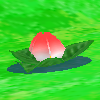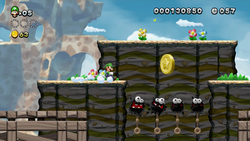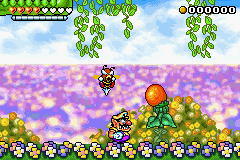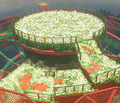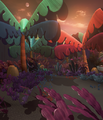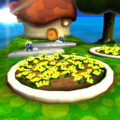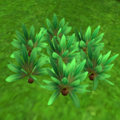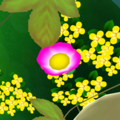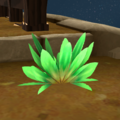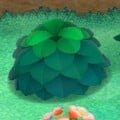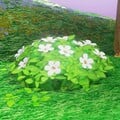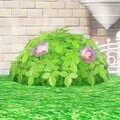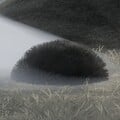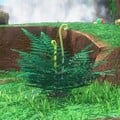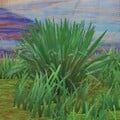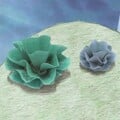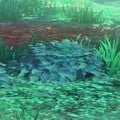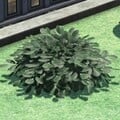Flower (environmental object)
- This article is about low-growing, interactable plants. For different subjects of the same name, see Flower.
| Flower | |||
|---|---|---|---|
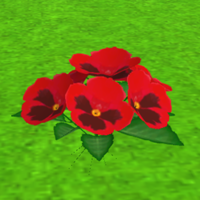 Screenshot from Super Mario Galaxy 2 | |||
| First appearance | Super Mario Bros. 3 (1988) | ||
| Latest appearance | Super Mario Bros. Wonder (2023) | ||
| |||
Flowers[1][2][3][4]:147 appear in the Super Mario franchise as recurring interactable objects of the environment. In games of the 3D Super Mario series, flowers most often conceal collectible items or hide subjects of interests, such as Warp Points or Coin Coffers. In some games, such as New Super Mario Bros. Wii and Super Mario 3D World, flowers are vaguely asteraceous and overall cartoonish. In others, such as Super Mario Galaxy 2 and Super Mario Odyssey, flowers are more realistic and closely resemble a variety of real-world species, such as pansies, tulips, poinsettias, and lilies-of-the-valley. Starting with Super Mario Galaxy, broad-leaved bushes[5] (also called grass[2] or tall grass[4]:36) have appeared in many games alongside flowers and serve the same function.
Flowers have otherwise appeared throughout the Super Mario franchise as decorative elements that cannot be interacted with. They are the basis for many items, objects, locations, characters, and enemies, most significantly the carnivorous Piranha Plants.
History[edit]
Super Mario series[edit]
Super Mario 64 / Super Mario 64 DS[edit]
Flowers (referred to in at least one instance as tulips)[6] first appear in Super Mario 64, where they grow on the Bob-omb Battlefield and in Whomp's Fortress. Some flower beds release 1-UP Mushrooms when the surrounding coins are collected. Flowers on the Bob-omb Battlefield hide a Warp Point that brings Mario to another flower bed. In the original Nintendo 64 game, all of the flowers are yellow and form hexagonal beds. In Super Mario 64 DS, some of the flowers are pink, and the beds are more naturally shaped.
Super Mario Sunshine[edit]
In Super Mario Sunshine, pink flowers appear in Bianco Hills. They are always encountered with their buds closed to start out. As a yellow-green Pianta notes in Episode 1 of Bianco Hills (Road to the Big Windmill), Mario can water flowers by using FLUDD, causing them to bloom and make a high-pitched singing sound. For single flowers, this causes the flower to dispense a single coin. Many flowers are found arranged in large rings, particularly in the later episodes of Bianco Hills. When Mario sprays one of these with FLUDD, it blooms, but it does not dispense a coin and closes its bud again a few seconds later. However, if Mario causes all of the flowers in a ring to bloom at once (done most easily using the Sprinkler Squirt move performed by rotating ![]() and pressing
and pressing ![]() with the Squirt Nozzle equipped), they all dispense coins at once. In Super Mario Galaxy and Super Mario Galaxy 2, stone circles are introduced that are conceptually similar to these flowers.
with the Squirt Nozzle equipped), they all dispense coins at once. In Super Mario Galaxy and Super Mario Galaxy 2, stone circles are introduced that are conceptually similar to these flowers.
Pokeys and Pokey Pods have similar flowers on their heads, and they disguise themselves as them until Mario gets close (in fact, most rings of flowers contain a few disguised Pokey Pods mixed in with the real flowers). Pokeys' and Pokey Pods' flowers can be watered and bloom similarly to real ones, but they close back up quickly, do not sing, and never dispense any coins, which can help tip off that they are disguised enemies. Seedy Pods also have a yellow variant of these flowers on their heads, though they do not bloom when watered.
Super Mario Galaxy[edit]
The flowers and grasses in Super Mario Galaxy rustle when walked through. The ones that shimmer conceal collectible Star Bits and release them when stirred. Flowers only occur in well-lit grassy galaxies such as the Honeyhive Galaxy and Gusty Garden Galaxy. Grass occurs in poorly lit areas and dark galaxies, such as the Ghostly Galaxy and Bigmouth Galaxy. This is most apparent on the starting planet of the Good Egg Galaxy. The surface facing the sun is vibrant and bears flowers, whereas grass grows on the side that does not receive sunlight, amongst dead trees. Two interactive flowers in Super Mario Galaxy resemble cosmos and come in two varieties, one yellow and one blue. Low-growing, non-interactive flowers occur in the game as well that are nearly flush with the ground.
New Super Mario Bros. Wii[edit]
In the first New Super Mario Bros., flowers appear as decorative background elements with no interactive components, similar to horsetails in the original Super Mario Bros. Starting with New Super Mario Bros. Wii, these flowers are given interactive elements that are carried over in some subsequent New Super Mario Bros. games. They are typically found on grassy surfaces and mushroom platforms, and they appear with multiple colors and designs. When the player performs a swift motion near a flower—either a Spin Jump, a propeller-enabled spin, or a Ground Pound—its flowerhead rotates around the stem; if the player performs such a move close enough to the flower, it additionally releases a coin. Flowers pulsate to the vocal riffs of a level's music.
In New Super Mario Bros. Wii, coin-yielding flowers are widespread in World 1, World 5, and World 7. In Worlds 1 and 7, the petals on a flower have an outer rim that can be light blue, orange, or fuchsia, with the inner part of a petal being a very light shade of its rim's color, and the flower's disc is always yellow. In World 5, flowers have turquoise, violet, or magenta petals with a single light-colored spot at the outer end of each petal; each petal color corresponds to yellow-, blue-, or lime-colored discs, respectively.
Super Mario Galaxy 2[edit]
Flowers and grasses retain the same function in Super Mario Galaxy 2 that they did in the first Super Mario Galaxy. Some shimmering flora release coins instead of Star Bits when stirred. A greater variety of flower species occur in this game, with some resembling pansies, lilies, tulips, and hyacinths. Many of these flowers appear together on a small planetoid in the Supermassive Galaxy. The planetoid appears devoid of life, but landing on it causes all of the flowers to bloom. This same planetoid appears in the screenshot awarded to the player once they have collected 120 Power Stars. The final area of the Slimy Spring Galaxy is dotted with grass and lilies-of-the-valley.
New Super Mario Bros. U / New Super Luigi U / New Super Mario Bros. U Deluxe[edit]
In New Super Mario Bros. U and New Super Luigi U, flowers mainly appear in Acorn Plains, Soda Jungle, and Meringue Clouds. In New Super Mario Bros. U, some flowers also appear in the levels Tropical Refresher and Skyward Stalk of Sparkling Waters, while in New Super Luigi U, they are present in Beanstalk Jungle in the same world, as well as Mount Fuzzy in Rock-Candy Mines. In Boarding the Airship, flowers can be destroyed by Mecha Hand as it attacks, whether by its squashing or punching moves.
The flowers in Acorn Plains, Sparkling Waters, and Rock-Candy Mines have blue, yellow, or red petals, with the color transitioning into white towards the inner part of a petal. The flowers in Meringue Clouds also feature this gradient scheme but appear in indigo, pink, or fuchsia. In Soda Jungle, flowers reuse their color palettes from World 5 of New Super Mario Bros. Wii and have a notch at the tip of each petal.
Super Mario 3D Land / Super Mario 3D World[edit]
Flowers and bushes[5] appear throughout Super Mario 3D Land and Super Mario 3D World, retaining their function from Super Mario Galaxy and Super Mario Galaxy 2. The flowers appear as small clusters of cosmos and come in a variety of colors. In these games, using a move from a power-up (i.e., throwing a boomerang as Boomerang Mario through one or tail-whipping one as Tanooki Mario) has the same effect as walking through them, usually causing a coin to pop out and immediately be added to the player's total. In some instances, disturbing a flower knocks a Coin Coffer out of hiding or causes a trail of notes to appear.
Dandelions called Fluffs appear in both games, and they release an item when the player blows into their respective system's microphone.
Super Mario Odyssey[edit]
Flowers and bushes appear in Super Mario Odyssey. In lieu of power-ups, throwing Cappy at flowers can reveal the hidden item within. Coin piles can pop out of flowers and bushes. A wide variety of plants is introduced to satisfy this gameplay concept while maintaining the intended design of each location. For example, ferns appear in place of flowers in the Cascade Kingdom, and tumbleweeds appear in the Sand Kingdom. In some locations, bushes can be ground-pounded to release individual coins. In the Wooded Kingdom, Steam Gardeners cultivate flowers and are best known for giant white flowers. They are stolen by Bowser during the game.
Super Mario Bros. Wonder[edit]
When a player character waters the ground in their Elephant form, short-lived flower particles appear with designs based on those from the New Super Mario Bros. games. Flowers are otherwise a noninteractive but prominent visual element in Super Mario Bros. Wonder. The game takes place in the Flower Kingdom, which is inhabited by people called Poplins that grow flowers on their heads.
Wario Land 4[edit]
Flowers[7] are objects in Wario Land 4. They are encountered in Wildflower Fields only. If a Beezley alights onto a flower as it tries to attack Wario, it pauses and starts pollinating the flower momentarily, causing it to grow a berry that swells. The berry has four stages of swelling, and Wario can hit the berry at any time to release coins from it. The first stage gives small coins worth 10 each, the second stage gives a Bronze Coin worth 50, and the third stage (pictured) gives two Silver Coins worth 100 each. The last stage gives a single small coin worth 10, due to the fruit becoming rotten. A caterpillar can be seen eating it at this stage.
Super Smash Bros. series[edit]
Flowers appear in the backgrounds of the Golden Plains and Mushroom Kingdom U stages from Super Smash Bros. for Nintendo 3DS and Super Smash Bros. for Wii U, respectively. Both stages reappear in Super Smash Bros. Ultimate. They sway back and forth, just like they do in the New Super Mario Bros. series.
Gallery[edit]
Artwork[edit]
Sprites and models[edit]
Super Mario Odyssey (Soirée Bouquet brochure texture)
Super Mario Odyssey (Lost Kingdom brochure texture)
Screenshots[edit]
Super Mario Galaxy 2 (prerelease)
Super Mario Odyssey (bush from the Cap Kingdom)
Super Mario Odyssey (fern from the Cascade Kingdom)
Super Mario Odyssey (bush from the Sand Kingdom)
Super Mario Odyssey (bush from the Lake Kingdom)
Super Mario Odyssey (bush from the Wooded Kingdom)
Super Mario Odyssey (Soirée Bouquet from the Wooded Kingdom)
Super Mario Odyssey (bush from the Lost Kingdom)
Super Mario Odyssey (bush from the Metro Kingdom)
Super Mario Odyssey (bush from the Seaside Kingdom)
Names in other languages[edit]
| Language | Name | Meaning | Notes |
|---|---|---|---|
| Japanese | 草花[8]:185, 232 Kusabana |
Usually translated as "flower" and colloquially interchangeable with「花」in Japanese. It sometimes more strictly means "plants with flowers" or "grass and flowers", as「草」(kusa) translates to "grass" or "plant." | |
| 花[8]:105, 151 Hana |
Flower | Super Mario Sunshine, New Super Mario Bros. series | |
| 草[9] Kusa |
Plant | Super Mario Odyssey | |
| Spanish | Flor[?] | Flower |
See also[edit]
- Cactus – another recurring environmental plant in desert-themed areas
- Item container – an object in the Donkey Kong Country series that also releases items when interacted with
- Tree – another recurring environmental plant that functions like a pole
- Wow Bud – an interactive flower bud found throughout Super Mario Bros. Wonder
References[edit]
- ^ Pelland, Scott, and Dan Owsen (1996). The Super Mario 64 Nintendo Player's Guide. Redmond: Nintendo of America (English). Page 18.
- ^ a b Black, Fletcher (November 9, 2007). Super Mario Galaxy: PRIMA Official Game Guide (Collector's Edition). Roseville: Prima Games (American English). ISBN 978-0-7615-5713-5. Page 41.
- ^ Bueno, Fernando (November 15, 2009). New Super Mario Bros. Wii: PRIMA Official Game Guide. Roseville: Prima Games (American English). ISBN 978-0-307-46592-4. Page 5.
- ^ a b Browne, Catherine (May 23, 2010). Super Mario Galaxy 2: PRIMA Official Game Guide. Roseville: Prima Games (American English). ISBN 978-0-30746-907-6. Page 36 and 147.
- ^ a b von Esmarch, Nick (November 13, 2011). Super Mario 3D Land: PRIMA Official Game Guide. Roseville: Prima Games (American English). ISBN 978-0-307-89386-4. Page 52, 104.
- ^ Pelland, Scott, and Dan Owsen (1996). The Super Mario 64 Nintendo Player's Guide. Redmond: Nintendo of America (English). Page 24.
- ^ Wario Land 4 source code name (Czako_flower)
- ^ a b Sakai, Kazuya (Ambit), kikai, Akinori Sao, Junko Fukuda, Kunio Takayama, and Ko Nakahara (Shogakukan), editors (October 19, 2015). 『スーパーマリオブラザーズ百科: 任天堂公式ガイドブック』. Tokyo: Shogakukan (Japanese). ISBN 978-4-09-106569-8.
- ^ Sakai, Kazuya, and kikai, editors (2018). 『スーバーマリオ オデッセイ 公式設定資料集』. Tokyo: ambit (Japanese). ISBN 978-4-19-864696-7. Page 231.
- Flowers
- New Super Mario Bros. U objects
- New Super Mario Bros. Wii objects
- Super Mario 3D Land objects
- Super Mario 3D World objects
- Super Mario 64 objects
- Super Mario 64 DS objects
- Super Mario Galaxy objects
- Super Mario Galaxy 2 objects
- Super Mario Odyssey objects
- Super Mario Sunshine objects
- Wario Land 4 objects
